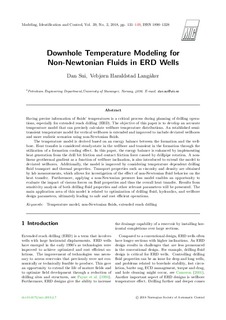| dc.contributor.author | Sui, Dan | |
| dc.contributor.author | Langåker, Vebjørn | |
| dc.date.accessioned | 2018-11-20T09:47:17Z | |
| dc.date.available | 2018-11-20T09:47:17Z | |
| dc.date.created | 2018-10-31T09:18:17Z | |
| dc.date.issued | 2018 | |
| dc.identifier.citation | Sui, D., Langåker, V. (2018) Downhole Temperature Modeling for Non-Newtonian Fluids in ERD Wells. 39(2), pp. 131-149 | nb_NO |
| dc.identifier.issn | 0332-7353 | |
| dc.identifier.uri | http://hdl.handle.net/11250/2573897 | |
| dc.description.abstract | Having precise information of fluids' temperatures is a critical process during planning of drilling operations, especially for extended reach drilling (ERD). The objective of this paper is to develop an accurate temperature model that can precisely calculate wellbore temperature distributions. An established semi-transient temperature model for vertical wellbores is extended and improved to include deviated wellbores and more realistic scenarios using non-Newtonian fluids. The temperature model is derived based on an energy balance between the formation and the wellbore. Heat transfer is considered steady-state in the wellbore and transient in the formation through the utilization of a formation cooling effect. In this paper, the energy balance is enhanced by implementing heat generation from the drill bit friction and contact friction force caused by drillpipe rotation. A non-linear geothermal gradient as a function of wellbore inclination, is also introduced to extend the model to deviated wellbores. Additionally, the model is improved by considering temperature dependent drilling fluid transport and thermal properties. Transport properties such as viscosity and density are obtained by lab measurements, which allows for investigation of the effect of non-Newtonian fluid behavior on the heat transfer. Furthermore, applying a non-Newtonian pressure loss model enables an opportunity to evaluate the impact of viscous forces on fluid properties and thus the overall heat transfer. Results from sensitivity analysis of both drilling fluid properties and other relevant parameters will be presented. The main application area of this model is related to optimization of drilling fluid, hydraulics, and wellbore design parameters, ultimately leading to safe and cost efficient operations. | nb_NO |
| dc.language.iso | eng | nb_NO |
| dc.publisher | Norwegian Society of Automatic Control | nb_NO |
| dc.rights | Navngivelse 4.0 Internasjonal | * |
| dc.rights.uri | http://creativecommons.org/licenses/by/4.0/deed.no | * |
| dc.subject | petroleumsteknologi | nb_NO |
| dc.subject | temperature model | nb_NO |
| dc.subject | non-Newtonian fluids | nb_NO |
| dc.subject | extended reach drilling | nb_NO |
| dc.title | Downhole Temperature Modeling for Non-Newtonian Fluids in ERD Wells | nb_NO |
| dc.type | Journal article | nb_NO |
| dc.type | Peer reviewed | nb_NO |
| dc.description.version | publishedVersion | nb_NO |
| dc.rights.holder | (C) 2018 Norwegian Society of Automatic Control | nb_NO |
| dc.subject.nsi | VDP::Teknologi: 500::Berg‑ og petroleumsfag: 510::Petroleumsteknologi: 512 | nb_NO |
| dc.source.pagenumber | 131-149 | nb_NO |
| dc.source.volume | 39 | nb_NO |
| dc.source.journal | Modeling, Identification and Control | nb_NO |
| dc.source.issue | 2 | nb_NO |
| dc.identifier.doi | doi:10.4173/mic.2018.2.7 | |
| dc.identifier.cristin | 1625231 | |
| cristin.unitcode | 217,8,6,0 | |
| cristin.unitname | Institutt for energi- og petroleumsteknologi | |
| cristin.ispublished | true | |
| cristin.fulltext | original | |
| cristin.qualitycode | 1 | |

